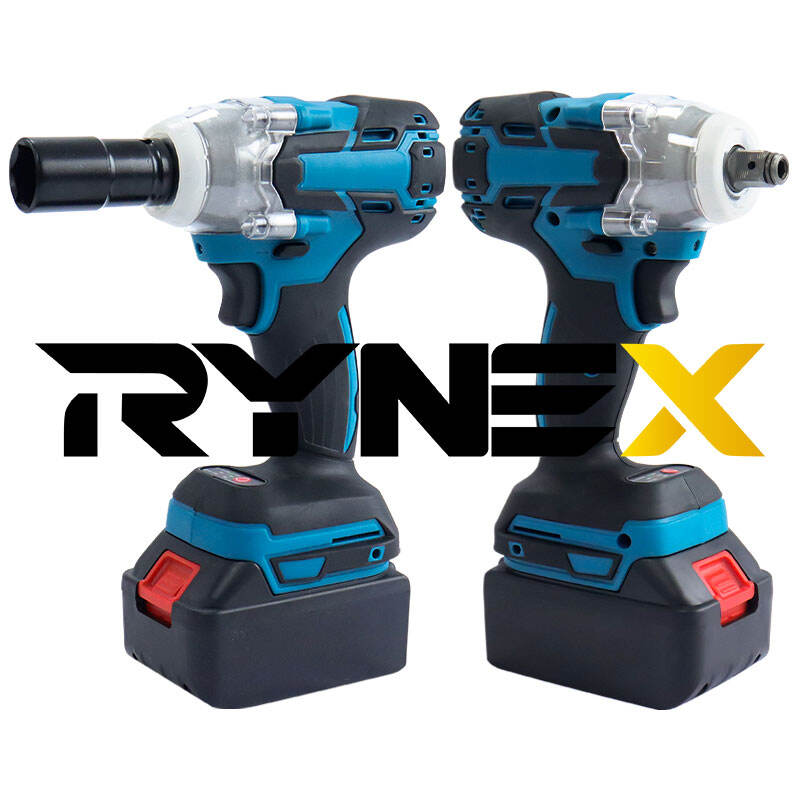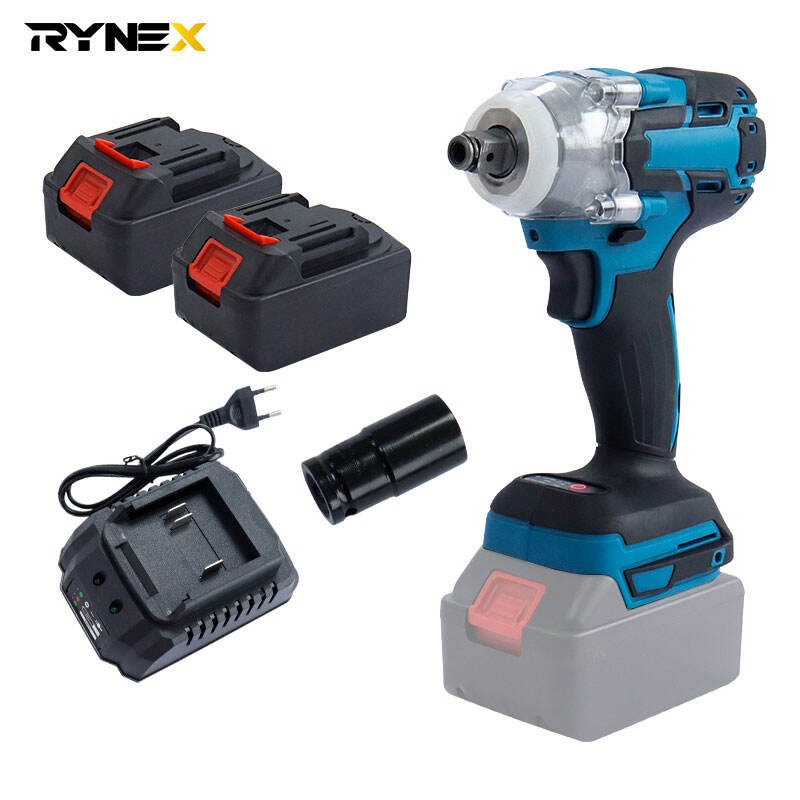Понимание требований к крутящему моменту при выборе беспроводного ключа
Роль крутящего момента в эффективности беспроводного ключа
Крутящий момент является ключевой характеристикой, которая может определить эффективность беспроводных гаечных ключей. Крутящий момент по сути представляет собой вращающуюся силу, которую эти инструменты применяют к крепежу. Эта вращающая сила важна для снятия, закрепления и поворота гаек, болтов и саморезов в таких областях, как строительство и автопром. Эффективность беспроводного гаечного ключа обычно оценивается его способностью обеспечивать необходимый объем крутящего момента для работы — что существенно влияет на качество и результат этой работы.
Уровень крутящего момента является тем, что гайки и болты требуют как в строительстве, так и в автомобильных приложениях, чтобы быть установленными правильно без риска повреждения. Например, исследования показали, что корреляция между уровнем крутящего момента и успешным креплением различается от одного материала к другому — например, древесины, металла и пластиков. Правильное количество крутящего момента может предотвратить повреждение, вмятины или разрушение крепежа или материала, фиксирующего крепеж. Исследования в отрасли показывают, что когда используются правильные настройки крутящего момента, производительность может увеличиться, а частота неудач при креплении может снизиться.
Расчет потребности в крутящем моменте на основе размера и материала крепежа
Чтобы знать, сколько момента необходимо для выполнения задачи, нужно знать размер крепежа и материалы, в которые он устанавливается. Начинать следует с измерения диаметра и шага резьбы крепежа, так как более крупные крепежи обычно требуют большего момента. Материал крепежа, а также материал, к которому применяется крепеж, также влияют на необходимый момент. Например, закручивание в мягкие материалы, такие как дерево, обычно не требует такого же момента, как при работе с металлом.
Примерный, простой коэффициент перевода для оценки необходимого момента может быть умножен на диаметр болта. Точные значения момента для различных классов крепежей указаны в ряде инженерных справочников. Эти указания важны, поскольку критически важно применять правильное количество момента, чтобы предотвратить повреждение или недозакручивание, что может нарушить конструкционную целостность и безопасность.
Диапазоны момента затяжки для распространенных проектов DIY и профессиональных работ
Знание средних уровней крутящего момента для профессиональных и DIY-проектов поможет вам легче выбрать беспроводной ключ. Проекты, связанные с такими hoạt độngями, как сборка мебели и некоторые автомобильные работы, обычно требуют от 30 до 150 фунт-футов крутящего момента, а аккумуляторные гаечные ключи будут достаточны для удовлетворения таких потребностей. С другой стороны, профессиональные специальности, занимающиеся обслуживанием промышленного оборудования или тяжелым строительством, могут потребовать ключей, способных обеспечить крутящий момент 250 фунт-футов или выше.
Проект, такой как ремонт автомобилей, требует точных настроек крутящего момента – например, затягивание гаек может потребовать 80–150 фунт-футов. Возможно, потребуется увеличить значение на несколько щелчков, если вы работаете с очень плотной твердой древесиной, но этого должно быть достаточно для большинства стыковок. Данные, полученные из нескольких кейс-стади, демонстрируют, что соблюдение предписанных пределов крутящего момента может привести к большим успехам в проектах, так как крепежи устанавливаются правильно, и не возникает структурных повреждений. Правильный крутящий момент не только гарантирует, что ваша работа будет качественной, безопасной и надежной, но также помогает предотвратить повреждение используемых материалов.
Оценка емкости и напряжения батареи для непрерывной работы
Ожидаемый срок службы батареи при длительном использовании
Важность мощности аккумулятора нельзя переоценить при оценке ударных ключей на батареях, особенно для задач, где вы будете использовать его длительное время. Размер аккумулятора, обычно измеряемый в мА·ч (или миллиампера-часах), непосредственно связан с тем, как долго ключ сможет работать без перерыва. Например, ключ с большим значением мА·ч проработает дольше, поэтому не нужно беспокоиться о необходимости остановки даже при работе над сложными проектами. Различные применения предъявляют разные требования к времени работы аккумулятора: высоконагруженные задачи (например, строительство) потребуют, чтобы аккумуляторы поддерживали производительность в течение более длительного времени. Исследования подтверждают, что большие аккумуляторы обеспечивают лучшее время работы в крупных инструментах для масштабных задач. Определение ёмкости аккумулятора важно для эффективности и результативности инструмента.
Требования к напряжению для тяжелых задач
Напряжение является одним из самых важных факторов беспроводного ключа с точки зрения количества мощности и производительности, особенно когда речь идет о тяжелых работах. Больше напряжения обычно означает больше выходной мощности, поэтому выбор оптимального напряжения важен для более сложных задач. Какие самые распространенные значения напряжения у беспроводных ключей? Большинство беспроводных ключей доступны с различными значениями напряжения от 12V до 20V, каждое из которых идеально подходит для конкретного применения. Например, ключи на 12V могут справиться с легкими и средними задачами, в то время как варианты на 18V-20V лучше подходят для более тяжелых работ. Инсайты из спецификаций: лучшая общая производительность — это то, что вы хотите, и вы получите это, выбрав правильный уровень напряжения, обеспечивающий достаточную мощность для выполнения задачи без перегрузки инструмента. Выбор напряжения для предполагаемого использования позволит вам получить максимальную мощность от вашего беспроводного ключа.
Оценка эргономики и размеров инструмента для комфорта
Учет веса при работе над головой или в ограниченных пространствах
Вес инструмента может быть важным фактором при использовании беспроводных гаечных ключей для работы в тесных пространствах или для работ над головой. Легкий ключ снижает усталость операторов и повышает производительность, особенно при более сложных работах над головой. В основном, беспроводные гаечные ключи относительно легкие — от 2 до 5 фунтов, при этом около 4 фунтов является распространенным диапазоном веса и хорошим балансом между мощностью и удобством использования, не создавая дополнительного напряжения для тела. Исследования показали, что более легкие инструменты повышают эффективность работы и уменьшают усталость оператора при длительных задачах.
Компактный дизайн против мощности: компромиссы
Выбор компактности или уровня мощности зависит от требований приложения. Более маленькие, беспроводные ключи лучше подходят для работы в ограниченных пространствах или когда требуется точность, тогда как более крупные варианты обеспечивают повышенную грузоподъемность. Например, в автомобильной промышленности нужен ключ с тонким профилем, чтобы перемещать детали, а в промышленности важнее получить больше мощности. Часто используются кейсы, чтобы продемонстрировать эти компромиссы и как эргономичные решения принимаются на основе максимизации производительности для разных задач, сохраняя комфорт пользователя.

Приоритизация скорости и характеристик производительности
Регулировка скорости для точной работы
Настройки скорости делают беспроводные гаечные ключи точными и универсальными. Эта функция позволяет пользователям устанавливать скорость, подходящую для конкретного применения, обеспечивая максимальный контроль и исключая повреждение резьбы. Например, при работе с такими предметами, как точные приборы или электроника, действительно необходима полностью регулируемая скорость. В этих случаях точный контроль скорости полезен для качественного выполнения работы с минимизацией возможного повреждения. Большинство универсальных ударных гаечных ключей, предназначенных для общего использования, доступны либо с приводом 3/8 дюйма (10 мм), либо с приводом 1/2 дюйма (13 мм), однако также существуют приводы 1/4 дюйма (6 мм), 1/2 дюйма (13 мм), 3/4 дюйма (19 мм), 1 дюйм (25 мм) и 1-1/2 дюйма (38 мм). Наиболее распространенным источником питания для ударных ключей является сжатый воздух, но также часто используются электрические или гидравлические источники энергии, причем электрические постепенно становятся более популярными благодаря своей мобильности. Январь 2021. Эта универсальность критически важна для специалистов, которым требуется компромисс между производительностью и точностью.
Оптимизация ударной частоты (IPM) и оборотов (RPM)
IPM и RPM влияют на эффективность беспроводного ключа. Эти характеристики оказывают большое влияние на способность инструмента применяться для различных задач. Это связано с тем, что некоторые крепежные операции требуют более высоких настроек (например, для ввинчивания больших болтов в твердые материалы), тогда как другие нет, что делает их более подходящими для тяжелой или легкой работы. С другой стороны, низкие настройки позволяют сохранить контроль и чувствительность, чтобы использовать его для более хрупких работ, таких как ремонт электронных устройств. Показатели промышленных тестов указывают на то, что оптимизация значений IPM и RPM может привести к повышению производительности при выполнении задач, и многие операторы отмечают улучшенную способность инструмента при соответствующей настройке IPM и RPM под конкретные задачи. Обратная связь от специалистов неоднократно подчеркивала преимущества инструмента с множеством легко регулируемых настроек для удовлетворения различных потребностей.
Сравнение гарантий, отзывов и надежности бренда
Важность репутации бренда при длительном использовании
Распознаваемость бренда важна для уверенности и удовлетворенности пользователей беспроводных ключей. Если это хороший, надежный бренд, который известен, то обычно у него есть хорошая репутация в плане последовательного качества продукции и хорошей поддержки конечного пользователя. Этот статус дает покупателям уверенность в том, что их покупка будет приносить пользу на протяжении многих лет. Метрики лояльности и удовлетворенности клиентов обычно показывают более высокие значения для DeWalt и Bosch, отражая их качество и постоянство в линейках продуктов. Согласно отчету MarketWatch, 72 процента потребителей склонны больше покупать у компаний, которым доверяют, предположительно снова и снова. Кроме того, эксперты отмечают, что инструменты от известных брендов служат дольше, так как они изготовлены из качественных материалов и покрыты длительными гарантиями.
Анализ отзывов клиентов для получения практических инсights
Отзывы пользователей являются отличным источником «реального» взгляда на производительность и надежность беспроводных воротков. Паттерны в отзывах – важно знать, что постоянно упоминается, например, повторяющиеся похвалы или жалобы на определенные функции или аспекты удобства использования. Например, возможно, отзывы регулярно упоминают аккумулятор из-за его длительного срока службы, или упоминают комфорт при хвате, или где его можно улучшить. В большинстве случаев количественные данные в онлайн-опросах подтверждают эти выводы; например, опрос Consumer Reports показал, что 84 процента людей заявили, что они были очень довольны продуктами, когда отзывы повлияли на их решение о покупке. Такие данные необходимы для оценки качества продукта с точки зрения пользователя и для понимания практической производительности инструмента в повседневных задачах. Эти отзывы служат важнейшим ресурсом для покупателей в плане спецификаций и сравнения пользовательского опыта с другими аналогичными моделями, доступными на рынке.
Часто задаваемые вопросы
Почему крутящий момент важен в беспроводном гаечном ключе? Крутящий момент важен, потому что он определяет вращающее усилие, прилагаемое гайковертом, гарантируя, что крепежные элементы будут правильно затянуты без повреждений.
Как я могу определить правильный крутящий момент для моего проекта? Учитывайте размер крепежа и материал, используя руководства из инженерных справочников или отраслевых стандартов для поиска подходящих значений момента.
Что я должен учитывать при выборе батареи для длительного использования? Ищите батарею с высоким значением миллиампер-часов (mAh), чтобы обеспечить более длительную непрерывную работу, подходящую для сложных задач.
Как напряжение влияет на производительность беспроводного гайковерта? Более высокое напряжение часто означает большую выходную мощность, которая необходима для тяжелых работ, требующих значительного усилия.
Почему репутация бренда важна при выборе беспроводного гайковерта? Достойная репутация бренда указывает на надежность и долговечность, часто подкрепленную отзывами клиентов и расширенными гарантиями.
Содержание
-
Понимание требований к крутящему моменту при выборе беспроводного ключа
- Роль крутящего момента в эффективности беспроводного ключа
- Расчет потребности в крутящем моменте на основе размера и материала крепежа
- Диапазоны момента затяжки для распространенных проектов DIY и профессиональных работ
- Оценка емкости и напряжения батареи для непрерывной работы
- Ожидаемый срок службы батареи при длительном использовании
- Требования к напряжению для тяжелых задач
- Оценка эргономики и размеров инструмента для комфорта
- Учет веса при работе над головой или в ограниченных пространствах
- Компактный дизайн против мощности: компромиссы
- Приоритизация скорости и характеристик производительности
- Регулировка скорости для точной работы
- Оптимизация ударной частоты (IPM) и оборотов (RPM)
- Сравнение гарантий, отзывов и надежности бренда
- Важность репутации бренда при длительном использовании
- Анализ отзывов клиентов для получения практических инсights
- Часто задаваемые вопросы

